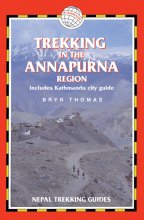Trailblazer guidebooks provide practical information on specific routes in less accessible parts of the world.
— Wanderlust

Trekking in the Annapurna Region
Excerpt:
Introduction
Contents List | Introduction | With a group or independently? | When to go | Minimum impact trekking | Sample route
INTRODUCTION

The history of trekking in Nepal is surprisingly short. Until 1948 the borders of this mysterious Himalayan kingdom remained firmly closed to outsiders and the race to climb Mt Everest, which had begun in the 1920s, was conducted from Tibet. As the first mountaineers entered the country reports of their exploits were widely publicized. The first peak over 8000m or 26,000ft to be climbed was Annapurna, by Frenchman Maurice Herzog, in 1950. Everest was conquered by Edmund Hillary and Tenzing Norgay with a British team in 1953.
The ensuing blaze of publicity focused world attention on Nepal and in 1955 Thomas Cook organized the first guided tour to Kathmandu. The tourists were welcomed and entertained by Boris Lissanevitch, the legendary White Russian who ran the only Western-style hotel in the country. They were met by the late King Mahendra who is reported to have watched in disbelief as the tourists haggled amongst each other to buy up all the curios they were shown. The King immediately recognized a source of foreign exchange of rich potential and the experiment in tourism was declared a success. An industry was born that is now the country's top foreign currency earner.
While Boris Lissanevitch is often credited with being the father of tourism in Nepal, the man who initiated the sport of trekking is Colonel Jimmy Roberts. He led a small party of American tourists on a short trek in 1964, with porters, tents and all the paraphernalia of a mountaineering expedition. This set the style for guided treks and is essentially how they are organized today. The word ‘trek’ is derived from the ‘Vortrekkers’, the Dutch pioneers who travelled across South Africa in their ox-carts.
The trekking routes themselves are nothing new, having existed as a network of paths ever since there have been people in the mountains. Some, such as the trail up the Kali Gandaki, are old trade routes leading to Tibet. For as long as there have been traders driving their pack animals along these routes there have been bhattis, tea houses where they could get a meal and spend the night. Discovered by budget travellers in the 1960s, tea-house trekking is now the most popular way to trek in Nepal.
Had Robert Louis Stevenson lived today and had the opportunity to go trekking his ‘To travel hopefully is a better thing than to arrive’ might well have emerged as that favourite misquotation, ‘It is better to travel than to arrive’. Trekking is most emphatically not about arriving; the interest and enjoyment is along the way. Trekking is about walking at whatever speed suits you, slow or fast, for as many or as few hours per day as give you time to enjoy the scenery and to experience something of the culture; here an ancient, Tibetan culture. There could surely be no better place to do this than among the highest mountains and deepest valleys in the world, with some of its most friendly and welcoming people.
Latest tweets